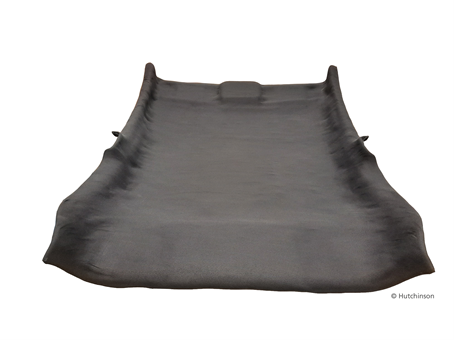Improved form-stable phase change materials
Result from partners Hutchinson and Fraunhofer LBF.
Result has been achieved in December 2020 : month 38 of the project.
Short introduction
New challenges are rising for thermal management in relation to e-mobility. The primary influences on the range of electric vehicles are the traction battery and the drive system. The temperature-dependent performance of the battery and the energy savings in the auxiliaries, e.g. air conditioning in passenger compartment, have a major influence on the battery range. Phase change materials (PCMs) store a large part of the energy supplied to them in the form of latent heat, e.g. during phase transition from a solid to a gel-like or liquid state. These functional materials are being used in the thermal management of electric vehicles more and more.
News item
A range of requirements has to be met for the use of PCM in electric cars. In addition to keeping weight as low as possible, high enthalpies during the changes in thermodynamic state are necessary and need to go on in the desired temperature window from 5 – 15°C. Due to their high enthalpies of melting and crystallization, paraffins now find particular use here. Making sure to prevent any leakage of paraffin during the lifetime is very important for the safe use of these phase change materials.
Objective
In the EU project DOMUS, novel form-stable phase change materials were developed based on thermoplastic styrene block copolymers (SEBS and SEEPS). These are set apart by the fact they can absorb larger volumes of paraffin (in this case, for hexadecane up to 90 weight %) than, for instance, polyolefins (up to max. approx. 75 – 80 weight%) and keep their dimensional stability at the same time.
Results
At Fraunhofer LBF, structure-property relationships were studied within these new systems for the first time. The materials were then optimized based on this. As a result, it was possible to achieve enthalpies of up to 195 J/g with high thermo-mechanical and dimensional stability. The leakage behavior, represented by the mass loss at higher temperatures, can be minimized through the tailoring of the molecular structure.[1] Form-stable plates were then produced from these materials by hot pressing. Macro-encapsulation with barrier films impermeable to paraffin makes it possible to create functional pads with almost no leakage of paraffin under laboratory conditions. As part of the ongoing DOMUS project, the materials developed at Fraunhofer LBF were integrated at HUTCHINSON, our development partner, in the headliner of a vehicle (see Figures 1 and 2). Finally, this headliner was integrated in the DOMUS prototype; the latter is now being physically evaluated within the demo-car related to DOMUS Result 5.
Figure 1: Positioning of the macro-encapsulated PCM pads in the middle of the car‘s roof at HUTCHINSON
Figure 2: Headliner with integrated PCM pads, after covering with the textile.
Impact
Compared to form-stable PCMs with polyethylene (PE) as the supporting material, the novel thermoplastic styrene block copolymers (SEBS/SEEPS) based PCMs can nearly store up to 30% more paraffin by weight. This offers the opportunity to optimize the ratio of active (paraffin) to the non-active (supporting materials, e.g. PE or SEBS/SEEPS) within the functional pads. In the consequence, weight savings of up to one third at the same latent heat capacity might be realized. Overall, this might be one building block for an efficient thermal management within the passenger compartment; this helps to save electrical energy from the battery.
[1] R. Rickert, R. Klein, F. Schönberger, Materials 2020, 13, 3285; doi:10.3390/ma13153285, Materials | Free Full-Text | Form-Stable Phase Change Materials Based on SEBS and Paraffin: Influence of Molecular Parameters of Styrene-b-(Ethylene-co-Butylene)-b-Styrene on Shape Stability and Retention Behavior (mdpi.com).




